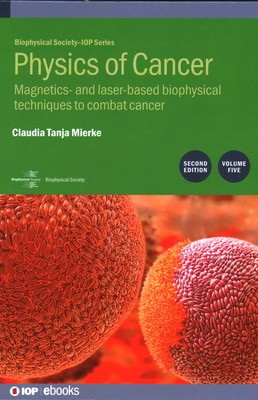
- We will send in 10–14 business days.
- Author: Claudia Tanja Mierke
- Publisher: IOP Publishing Ltd
- ISBN-10: 0750362723
- ISBN-13: 9780750362726
- Format: 17.8 x 25.4 x 3.3 cm, kieti viršeliai
- Language: English
- SAVE -10% with code: EXTRA
Physics of Cancer, Volume 5 (Second Edition) (e-book) (used book) | bookbook.eu
Reviews
Description
This is the fifth volume of the highly regarded 'Physics of Cancer (Second Edition)' series, written with the aim of making very important topics in the physics of cancer visible to the research community. This fifth volume deals with biophysical methods. The first chapter presents the traditional NMR techniques and introduces the relatively new MRE technique for the characterization of cancer cells and tissues. The second chapter provides an overview of magnetic tweezer techniques relevant to cell characterization. The third chapter focusses on the magnetic twisting cytometry techniques. The fourth and fifth chapters discuss the cytoskeletal remodeling dynamics from a biological viewpoint and a physical viewpoint, respectively. The optical tweezer is introduced in the sixth chapter and the optical cell stretcher is discussed in the seventh chapter. In the eighth chapter, microfluidics-based high-throughput cell stretching is discussed and the latest developments are presented.
Key Features
- Fifth volume of the author's 'Physics of Cancer (Second Edition)' books, a highly regarded series
- Comprises chapters that have been designed as self-contained units
- Written by a widely respected expert in the physics of cancer field
- Covers state-of-the-art techniques that were developed by the author
- Includes research findings that have been presented in numerous peer-reviewed journal articles
- Contains extensive references at the end of each chapter to enhance further study
EXTRA 10 % discount with code: EXTRA
The promotion ends in 23d.09:46:13
The discount code is valid when purchasing from 10 €. Discounts do not stack.
- Author: Claudia Tanja Mierke
- Publisher: IOP Publishing Ltd
- ISBN-10: 0750362723
- ISBN-13: 9780750362726
- Format: 17.8 x 25.4 x 3.3 cm, kieti viršeliai
- Language: English English
This is the fifth volume of the highly regarded 'Physics of Cancer (Second Edition)' series, written with the aim of making very important topics in the physics of cancer visible to the research community. This fifth volume deals with biophysical methods. The first chapter presents the traditional NMR techniques and introduces the relatively new MRE technique for the characterization of cancer cells and tissues. The second chapter provides an overview of magnetic tweezer techniques relevant to cell characterization. The third chapter focusses on the magnetic twisting cytometry techniques. The fourth and fifth chapters discuss the cytoskeletal remodeling dynamics from a biological viewpoint and a physical viewpoint, respectively. The optical tweezer is introduced in the sixth chapter and the optical cell stretcher is discussed in the seventh chapter. In the eighth chapter, microfluidics-based high-throughput cell stretching is discussed and the latest developments are presented.
Key Features
- Fifth volume of the author's 'Physics of Cancer (Second Edition)' books, a highly regarded series
- Comprises chapters that have been designed as self-contained units
- Written by a widely respected expert in the physics of cancer field
- Covers state-of-the-art techniques that were developed by the author
- Includes research findings that have been presented in numerous peer-reviewed journal articles
- Contains extensive references at the end of each chapter to enhance further study


Reviews